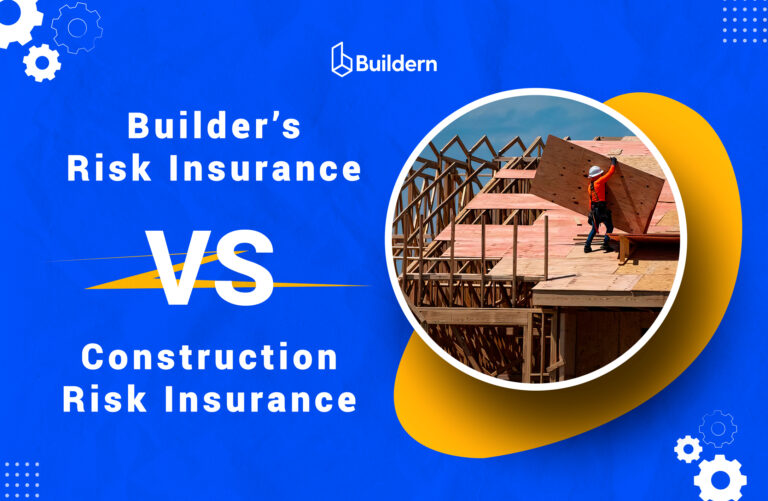Construction Purchase Order: Definition, Workflow, and Benefits
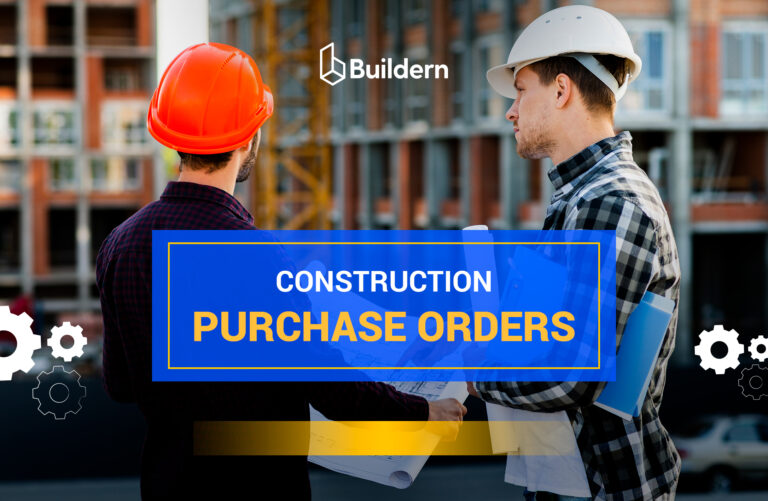
One overlooked purchase order (PO) can disturb an entire timeline. One missing detail can lead to thousands in unexpected costs.
Procurement, especially in construction, isn’t only about placing orders. Here, we have control over risk, stay within budget, and keep vendors aligned with the job. Still, many construction teams rely on multiple tools and informal processes, which often leads to delays, miscommunication, and duplicate spending.
In this article, we’ll figure out how to manage construction purchase orders and keep procurement aligned with your project goals. We’ll clarify who’s buying what, at what price, and under what terms.

Table of Contents
- What Is a Construction Purchase Order?
- PO vs. Subcontract: Key Differences Builders Should Know
- Why Construction Teams Rely on Purchase Orders
- What Every Purchase Order Should Include
- PO Types And When to Use Each
- Step-by-Step: How the PO Process Works
- Avoiding The Most Common PO Issues
- Best Practices for PO Management
What Is a Construction Purchase Order?
In simple words, a construction purchase order is a formal document used to authorize and track the purchase of materials, equipment, or services from a vendor. Issued by a contractor or project manager, it outlines the items being ordered, quantities, pricing, delivery expectations, and payment terms. Once the supplier accepts it, the PO becomes a binding agreement and part of the project’s financial records.
Interestingly, it plays a dual role. In the field, it provides clarity for deliveries (what’s expected, when, and where). In the office, it integrates with the construction budgeting process, supports construction forecasting, and helps enforce approval workflows.
A well-managed PO reduces confusion, protects profit margins, and keeps procurement aligned with the construction schedule and cost structure.
👉 For smaller teams or growing businesses, incorporating POs into Buildern’s structured system is often the first step toward full construction project management software adoption.
PO vs. Subcontract: Key Differences Builders Should Know
These both are for controlling project spending, but serve slightly different purposes. A PO is typically used to secure materials, equipment, or rentals. It’s transactional, short-term, and focused on line items and delivery terms.
In contrast, a Subcontract outlines a broader scope of work for trades or service-based contractors. It involves schedules, responsibilities, and legal requirements such as insurance or safety compliance.
Understanding use cases for each might help construction teams improve documentation, reduce delays, and maintain tighter control over budgets and timelines.
| Feature | Purchase Order | Subcontract |
| Use case | Ordering materials, equipment, or rentals | Hiring trades or vendors for labor and services |
| Structure | Itemized: quantity, pricing, delivery terms | Task-based: scope of work, timeline, and conditions |
| Duration | Usually short-term or one-off | Often long-term or linked to project phases |
| Level of detail | Specific costs and quantities | Detailed responsibilities, milestones, and dependencies |
| Legal Requirements | Basic terms, commercially focused | Includes insurance, licensing, and legal provisions |
| Vendor type | Suppliers, rental companies | Subcontractors (plumbing, electrical, framing, etc.) |
👉 Furthermore, Buildern supports both document types through tailored workflows that keep procurement and labor contracts tied to the same job cost structure. Whether your team is issuing a PO for concrete or assigning a framing scope to a subcontractor, everything stays connected under one platform.
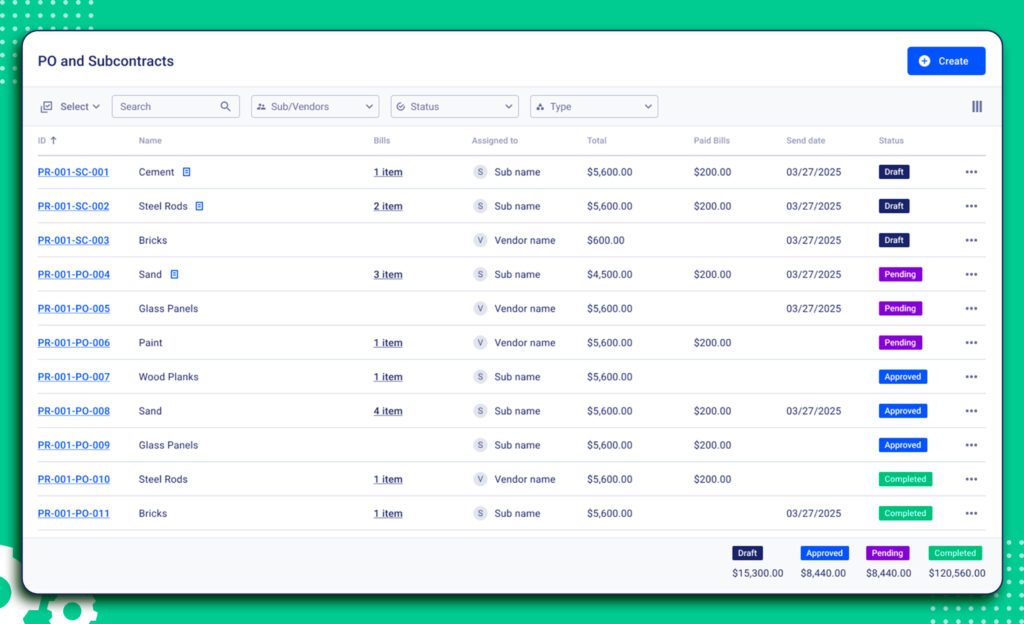
Why Construction Teams Rely on Purchase Orders
A PO adds control before any money is spent. It confirms that the quote was reviewed, the pricing approved, and the agreement formally documented. Additionally, this prevents unordered deliveries, unexpected invoices, and payment disputes.
Field workers use POs to see exactly what was ordered and what to expect on site. Office staff track each purchase against the budget and follow internal approval rules to keep spending in check.
Without a structured PO process, tracking costs, catching overruns, or resolving vendor issues becomes increasingly difficult as the project progresses.
What Every Purchase Order Should Include
A purchase order is more than a formality as it’s a key control document that keeps your procurement process organized, traceable, and aligned with the project’s financials. It needs to include the right information from the start. Missing or unclear details often lead to vendor disputes, delivery delays, and budget mismatches.
Typically, a complete PO should contain:
- Vendor information, including company name, primary contact, and tax ID
- PO number, issue date, and associated project reference for internal tracking
- Detailed list of items or services, specifying quantities, units of measure, unit pricing, and total costs
- Delivery address and delivery window, including any site-specific requirements
- Billing instructions, with contact information for invoicing and notes on payment terms
- Approval contact and status, showing who authorized the order and when
- Additional notes or conditions, such as substitution rules, backorder policies, or attached documentation
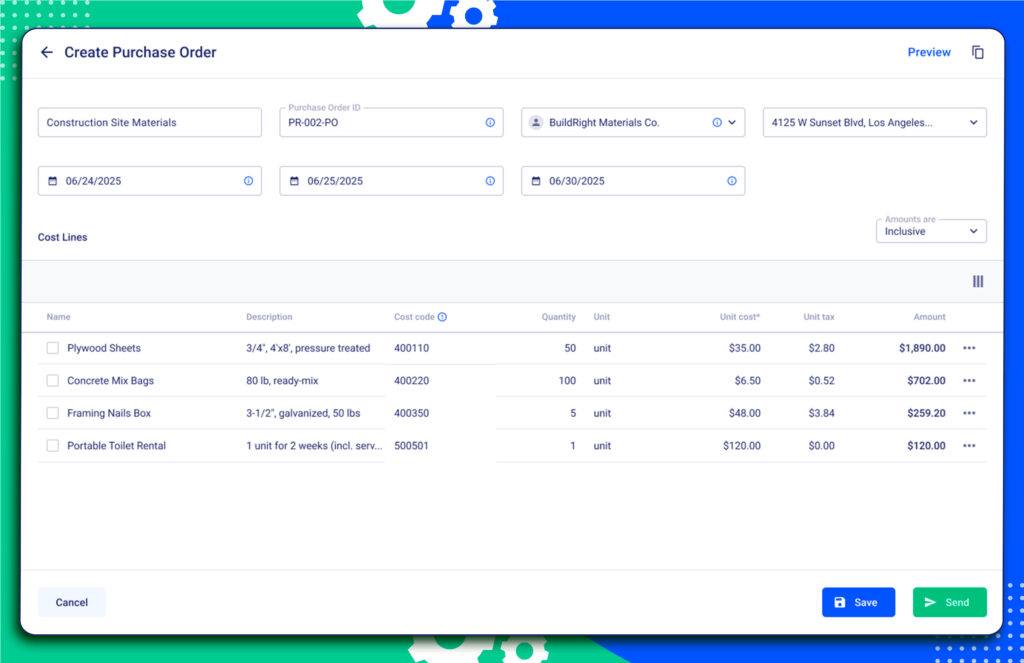
PO Types And When to Use Each
Not every purchase follows the same pattern. The structure and timing of what you’re buying should determine the type of PO you issue. Most construction teams rely on these three:
Standard Purchase Orders
Teams use standard purchase orders for one-off transactions with clearly defined scope, pricing, and delivery terms. These are common for materials like framing lumber, electrical fixtures, or HVAC units, where the requirements, timing, and costs are already set.
Blanket Purchase Orders
Best for high-volume or repeat orders from the same vendor. Instead of creating a new PO each time, one blanket PO covers multiple shipments over a period. This works well for recurring items like drywall, concrete, or fasteners, where quantities may change but the supplier and pricing stay the same.
Planned and Contract Purchase Orders
A planned PO reserves budget for future purchases when the scope is clear but the schedule isn’t fixed. A contract PO locks in pricing and terms ahead of time, with separate release orders sent as materials or services are needed. Both types work well for multi-phase or long-term projects that demand flexibility and tighter cost control.

Step-by-Step: How the PO Process Works
In construction, an untracked purchase can disrupt both the field and the budget. But Buildern simplifies these workflows, connecting procurement directly to your estimates, cost codes, and approval chains.
Here’s how the process works inside:
1. Identify the Need
A project manager or estimator determines the need for materials, equipment, or services. This usually comes from the schedule, a task in progress, or an upcoming phase.
2. Request and Compare Vendor Quotes
Quotes are gathered outside the platform and evaluated by the team. Once a sub/vendor is selected, the PO process begins.
3. Create the Purchase Order in Buildern
The PO is created directly from the estimate or cost breakdown. Buildern pulls in project information, cost codes, vendor details, and budget data automatically. Line items can be added manually or based on what was scoped in the estimate.
4. Submit for Internal Approval
The PO goes through Buildern’s internal approval system. Roles and rules define who must review and approve each PO. The approval history is tracked within the platform for full transparency.
5. Send to the Vendor
After internal approval, the team sends the PO to the vendor. It includes all key details such as quantities, pricing, delivery address, and the reference project.
6. Receive and Verify the Delivery
When the vendor delivers the materials, the field or receiving team checks whether the delivery matches the PO. Delivery records can be uploaded or noted inside Buildern.
7. Match Against the Invoice
The team submits the invoice for review. With Buildern, they compare it against the PO and delivery record to catch any discrepancies. If all details match, they move forward with payment. If not, they flag the issue and resolve it before processing.
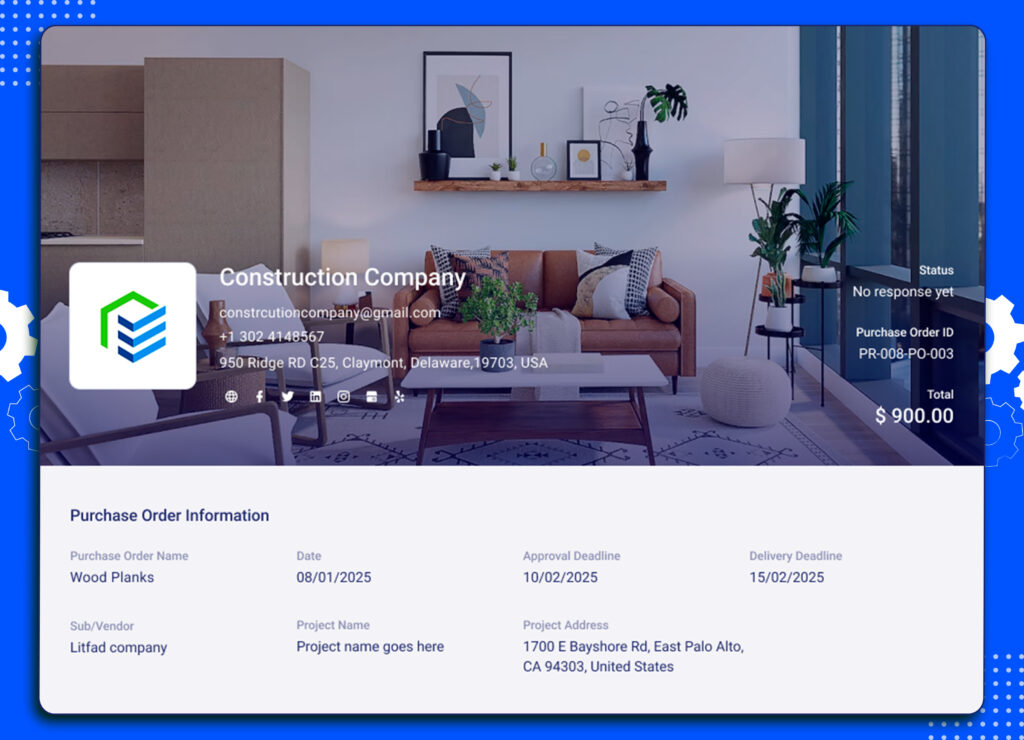
Avoiding The Most Common PO Issues
Even with a formal process in place, POs can still create problems if they aren’t managed carefully. The most common issues usually come down to poor communication, lack of visibility, or disconnected documentation.
Here’s what to watch for:
Vague or Incomplete Information
When item descriptions are unclear or delivery details are missing, vendors are left to interpret what was intended. This leads to incorrect shipments, missed deadlines, and unnecessary back-and-forth.
💡Buildern helps avoid this by enforcing structured input and supporting attachments like spec sheets or drawings, so there’s no room for misinterpretation.
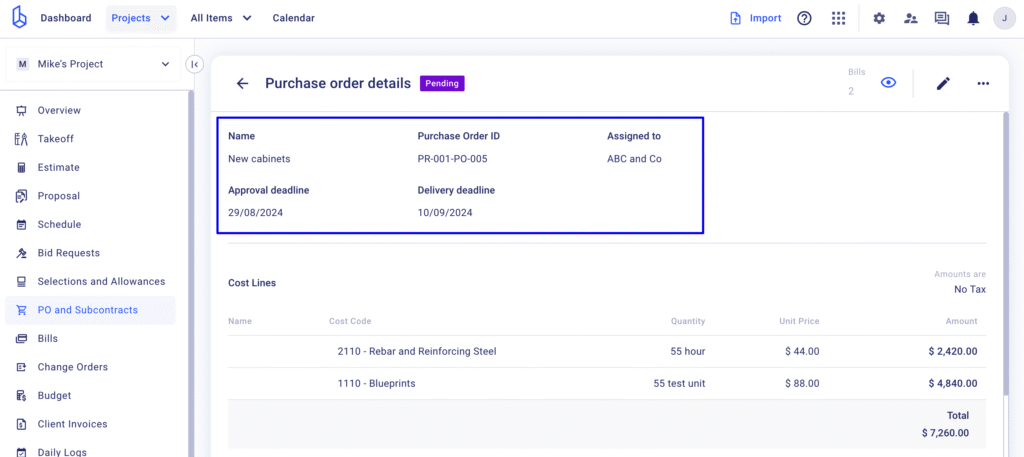
Duplicate Orders Across Teams
Without visibility across teams or departments, it’s easy for multiple people to place the same order. This not only wastes budget but also complicates delivery tracking and vendor coordination.
💡Buildern gives your entire team access to purchase order records by project, vendor, and date, ensuring no duplicate orders slip through.
Mismatched Paperwork and Payment Delays
If the invoice, delivery slip, and PO don’t match, payment approvals stall. These discrepancies often lead to delayed payments, frustrated subs & vendors, and wasted time for your accounting team.
💡Buildern’s built-in three-way matching flags inconsistencies early, making it easier to verify each invoice and keep payments moving on schedule.
Best Practices for PO Management
Strong PO management starts with consistency. When everyone follows the same process and works from the same system, it becomes much easier to avoid mistakes, speed up approvals, and maintain budget control.
These practices help teams stay on track:
Standardize PO Templates
Using a standardized PO format across projects helps teams avoid confusion and makes it easier for vendors to process orders correctly. Additionally, Buildern automatically includes key fields like project name, cost codes, and vendor details to ensure consistency with every PO issued.
Use Role-Based Approval Workflows
Not every purchase should go through the same approval path. Buildern allows you to define who needs to review a PO based on their role, cost category, or project. Once submitted, the system routes the PO to the appropriate person and logs every action, giving you full traceability and control.
Link Every PO to Your Budget and Cost Codes
To track budgets accurately and forecast costs, the team links each PO to the job’s estimate or cost breakdown. Buildern assigns every PO to a specific cost code, making it easy to monitor committed expenses and catch overruns early.
In the end, a well-run PO process keeps projects on track, vendors accountable, and costs aligned with your budget. It’s not about adding steps, but about gaining visibility and avoiding costly surprises. The right system makes it easier to stay in control from the first order to final payment.
What is a Construction Purchase Order, and Why Is It Important?
A construction purchase order (PO) is a formal document used to approve and track the purchase of materials, equipment, or services. It outlines key details like quantities, pricing, delivery terms, and payment conditions. Once accepted by the vendor, it becomes a binding agreement. POs provide cost control, clear communication, and accountability across the project lifecycle.
What’s The Difference Between a PO And a Subcontract?
A construction purchase order is typically used for materials, equipment, or rentals, short-term, itemized, and transaction-based. A subcontract is used for labor or trade work and includes a defined scope, timeline, and legal terms. Yet, Buildern supports both with separate workflows tied to job cost tracking.
What Should Be Included in a Construction PO?
A complete PO includes vendor details, project reference, item descriptions, quantities, unit pricing, delivery location, billing instructions, and internal approval info. Buildern adds all these fields by default and connects them directly to your budget and cost codes.
When Should I Use a Blanket Purchase Order?
Blanket POs are ideal when ordering the same type of material multiple times over a period. Instead of issuing new POs for each order, one blanket PO covers recurring deliveries under fixed terms. Buildern allows teams to manage these efficiently without creating duplicates.
What is three-way matching, and how does Buildern support it?
Three-way matching compares the PO, the delivery record, and the invoice. Buildern automates this process, flagging any mismatches before a payment is approved. It’s a key step in preventing overbilling, errors, and delays in payment processing.


![Detailed Construction Project Cost Breakdown [Examples Included]](https://buildern.com/resources/wp-content/uploads/2024/09/BLOG_Cover_Construction-project-cost-breakdown-2-copy-768x501.webp)
